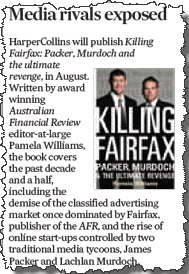What a difference a day makes. Yesterday, Fairfax said goodbye to business reporter Paddy Manning for speaking out against the company in Crikey. Today The Australian Financial Review spruiks an upcoming book by editor-at-large Pamela Williams. Its title? Killing Fairfax.
Publisher HarperCollins promises the tome will chronicle “a decade and a half of lost opportunity and mismanagement” and tell “the inside story of the decline of hallowed media company Fairfax”. HarperCollins is, of course, a subsidiary of Rupert Murdoch’s News Corporation — adding an extra frisson to the whole affair. Will The Fin, we wonder, run extracts to promote a book written by its star reporter, published by its chief rival, chronicling the “decline” of Fairfax? It’s almost too delicious to contemplate.

Fairfax has long prided itself on being more open and objective about its financial state than News Limited. If Williams’ book gets a big run it’ll be a sign that that culture still has some life in it. Reporting on your employer’s financial woes, it seems, is one thing; bagging it for running supposedly “rubbishy” content is another.
Williams’ book is not due on bookshelves until August. So why the PR push now, four months ahead of publication?
The move appears designed to steal the thunder of a slew of other Fairfax-themes books set to hit bookshops in coming months. There’ll be a big advantage for whoever gets their book out first — before the inevitable Fairfax fatigue sets in.
Williams’ former Fin Review colleague Colleen Ryan also has a Fairfax book due out in August. To be published by Louise Adler’s Melbourne University Press, it will be titled Who killed Fairfax? according to one online booskeller; another promotes it as The Rise and Fall of the House of Fairfax.
Former Fairfax investigative journalist Ben Hills is also writing a book on the topic for ABC Books (an imprint of HarperCollins).
In October, Sydney Morning Herald literary editor Susan Wyndham flagged that Ryan’s book would be the first on the shelves. That appears less certain now thanks to an all-out effort by Williams, who is on leave from The Fin churning out her manuscript.
The long-form journalism gun certainly seems to have stumbled upon a unique — and unexpected — angle for her opus. The preview of the book’s front cover is dominated by photos of Lachlan Murdoch and James Packer. According to HarperCollins, Williams’ book will reveal a “savage twist in the tale”: the online companies that have weakened Fairfax’s traditional dominance of classified revenues have been under the direct control of Murdoch and Packer. Both men apparently gave Williams “unprecedented and exclusive” access for the book.

So how exactly did the media princelings — and one-time One.Tel backers — kill Fairfax?
Williams declined to comment this morning, but this much is clear from the public record.
Packer bought 25% of job site Seek in 2003, became chairman of the company and upped his stake repeatedly before selling out in 2009. Seek is now the leading jobs site in Australia, ahead of Fairfax’s MyCareer and others. Packer also invested $100 million in carsales.com.au — which now leads the online motoring classifieds market — in 2005 and 2006.
And in late 2000, News Ltd snapped up 44% of realestate.com.au (now Australia’s largest property website and now majority owned by News). Lachlan Murdoch had just left the News Limited CEO gig to become deputy CEO of News Corp.
Williams’ book seems certain to spark debate about how many of Fairfax’s woes have been self-inflicted and how many can be sheeted home to the until-now unrecognised internet savvy of Packer and Murdoch.







Williams loves to back a winner.